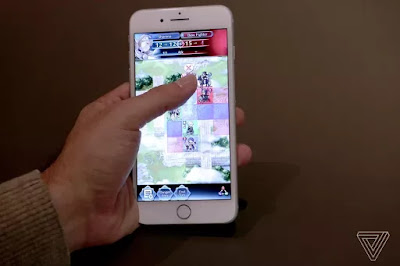Nintendo’s Fire Emblem Heroes is a complex strategy game with a free-to-play twist
 Nintendo’s second high-profile mobile game was announced just two weeks ago, but Fire Emblem Heroes is already slated to arrive in a just a few days. The game, a free-to-play take on the popular turn-based strategy series, arrives this Thursday for iOS and Android. It carries with it high expectations and
Nintendo’s second high-profile mobile game was announced just two weeks ago, but Fire Emblem Heroes is already slated to arrive in a just a few days. The game, a free-to-play take on the popular turn-based strategy series, arrives this Thursday for iOS and Android. It carries with it high expectations and understandable trepidation.
While Super Mario Run was a premium mobile game with a hefty price tag and Nintendo’s most recognizable mascot, Heroes is drawn from one of the company’s lesser known franchises. Its complex strategy combat and impenetrable fantasy lore may not translate to a more general audience, while Heroes’ controversial free-to-play structure has the potential to turn off long-time fans.
The good news: after I spent time with the game last week, it’s clear Heroes is a fun and surprisingly rich strategy game that plays to the strengths of mobile. Much like how Square Enix’s Final Fantasy Tactics became a superior experience when it integrated iOS touch control, Fire Emblem Heroes makes use of the best aspects of touchscreen gaming to emphasize strategic, board-based battles. Instead of having to manually select characters and tirelessly plot across large battlefields, Heroes shrinks down the board and lets you drag, drop, and slide characters to speed up play and create more bite-sized experiences.
It will undoubtedly be many gamers’ first Fire Emblem experience — it was mine, save for a few failed attempts at picking up the Nintendo 3DS games Awakening and Fates. And Heroes appears to be an accessible and well-designed entry for first-time players. It does not include “permadeath,” a staple of the series’ more serious entries that remains controversial among fans. That means if your characters die, you don’t lose them forever. It’s also filled with helpful tutorials that are easy to ignore if you’re a long-time fan, but will be much appreciated to those both new to Fire Emblem and to the strategy genre in general.
Aside from touch controls, the biggest difference between Heroes and past Fire Emblem games is how you pay for it. Following Super Mario Run, which used a freemium model that charged players $9.99 to play beyond the first three levels, Nintendo is using a standard free-to-play structure for Heroes. That means the game uses what are called time-gating strategies to prevent players from continuously accessing the most rewarding parts of the app without spending in-game currency. It sounds insidious, and there are certainly some egregious offenders in the mobile game space. Luckily, it seems like Nintendo is taking a fair route with its foray into free-to-play.
In short, Fire Emblem Heroes time-gating and currency system appear relatively straightforward, fair, and easy to understand. There are two elements at play. One is called stamina, which is a numbered meter that informs which missions you are able to play. It replenishes over time at a rate of about one point per hour to a total of 50. That’s okay early on, because prologue missions and other beginner portions of Heroes only cost one stamina point to play. However, harder missions and more difficult replays of already completed missions will cost more stamina to initiate.
The other important element is orbs, the standard in-game currency in Heroes. Orbs can replenish stamina — notably, one orb will replenish your entire stamina meter. But the currency can also be used for a number of other upgradable staples like expanding your castle and, more importantly, unlocking new heroes. Nintendo is calling this process summoning, and it essentially lets you spend a certain number of orbs to unlock new heroes through a randomized system not unlike a collectible toy machine.
You can pay real money for orbs — three orbs costing $1.99 — however, you can also earn them through in-game activities. So how you engage with Heroes’ free-to-play obstacles will ultimately depend on a few factors: how long you want to play per day, whether you care more about advancing in the story or collecting heroes, and how much real money you’d be willing to spend.
If you’re the type of player who loves collecting — Heroes has hundreds upon hundreds of heroes to collect — you may want to spend your orbs building out your roster. Nintendo is employing a star rating system to measure the effectiveness of heroes you unlock through summoning. That means you may have to spend some serious time rolling the dice to get a five-star version of a hero you want, instead of a four- or three-star one that may be more common. Heroes uses a rotating system of five-star heroes for character collections that will have a greater chance of showing up every week, and the percentages are clearly displayed before you decide to spend as many as five orbs to try and obtain one.
In my short time with the app last week, I was unable to determine whether the game supports a wide variety of play styles. It would seem, on the surface, that you could spend orbs to collect new heroes as you advance in the story here and there, so long as you make sure to keep a few orbs around to replenish stamina. I did not encounter any all-or-nothing stipulations or any roadblocks that seemed to blatantly force players to spend real money. But we’ll have to spend more time with the finished game to make a full assessment of how it treats players’ efforts and energy.


Comments
Post a Comment